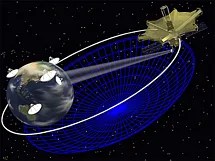HALCA
Highly Advanced Laboratory for Communications and Astronomy
Type
Launch
Target
Objective
HALCA was a very long baseline interferometry mission that allowed imaging of astronomical radio sources with significantly improved resolution over ground-only observations.

Launched on February 12, 1997 HALCA, also called VSOP, Muses-B or Haruka (meaning "far away"), was a very long baseline interferometry mission. Led by Japan's Institute of Space and Astronautical Science, the mission allowed imaging of astronomical radio sources with a significantly improved resolution over ground-only observations.
The spacecraft carried a wire mesh dish antenna 8 meter in diameter as one part of a radio astronomy interferometer, with the other part being any one of a number of ground-based radio telescopes. It carried detectors which operated at 1.6, 5 and 22 GHz (18, 6, and 1.3 cm, respectively). Using HALCA, a virtual radio telescope with an aperture of 30,000 km (about three times the earth's radius) was created.
The planned mission lifetime was 3-5 years. The actual mission lasted over 8 years before it was decommissioned on November 30, 2005.
Science Highlights
- The international VSOP team realized space VLBI for the first time in the world and observations of celestial bodies were conducted jointly with radio telescope networks on the ground across the world.
- Radio images with very high spatial resolution were generated which permitted precise measurements of quasar jets and galactic maser sources.
- Observed hydroxyl masers and pulsars at 1.6 GHz.
- The team was awarded the 2005 Laurel Award of IAA (International Academy of Astronautics).
Last updated: January 30, 2017




